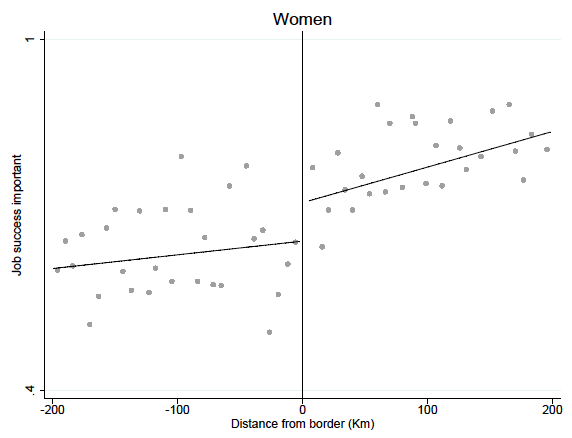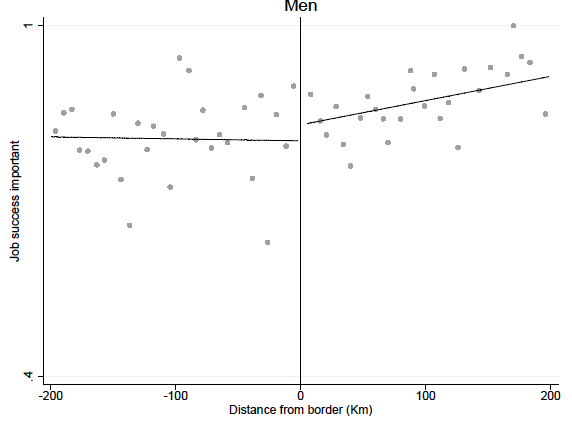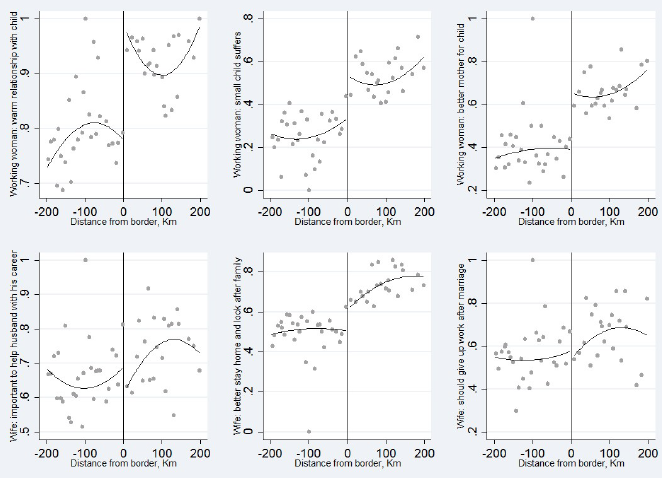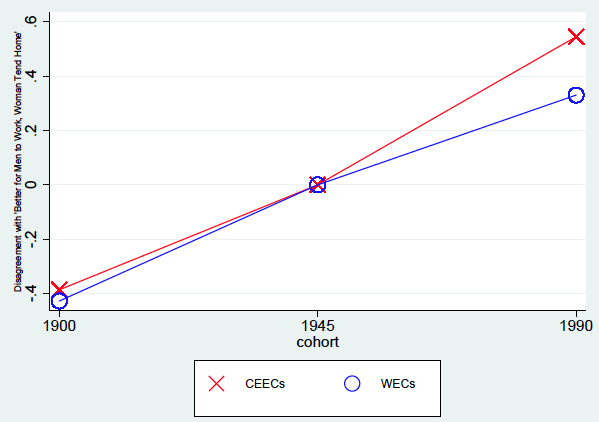Female attitudes toward work and attitudes towards gender roles in the population at large differ considerably over time and space. For instance, Giavazzi et al. (2013)observe variation in these attitudes over time for the period 1980–2000 in European regions and OECD countries. These attitudes have also been shown to have significant effects on labour market outcomes. Fortin (2008) presents evidence that gender differences in attitudes towards work have a significant role in accounting for the gender wage gap. Further, Fernández et al. (2004) show a substantial effect of attitudes towards gender roles on women’s labour force participation.
To what extent are these attitudes affected by politico-economic regimes and government policies? Answering the question of whether politico-economic regimes affect attitudes is complicated by the fact that regimes are not randomly assigned.
The state-socialism quasi-experiment
In a recent paper, we exploit the imposition of state-socialist regimes across Central and Eastern Europe and their efforts to promote women's economic inclusion, for both instrumental and ideological reasons (Campa and Serafinelli 2018). Between their rise to power in the late 1940s and up to the late 1960s, state-socialist governments throughout the region made efforts to promote women's economic inclusion — their rapid industrialisation and general plan for economic growth (based on an intensive use of labour) were dependent on such inclusion. Moreover, women's economic independence was seen as a necessary precondition for women's equality, a principle to which these governments were arguably committed, though many scholars claim that the need for female labour power was by far more relevant. Legal changes such as the adoption of the principle of equal work under equal conditions, new family laws, and education and training policies were used to further this goal.1 The employment of women increased throughout the region during this period. Within this historical context, we empirically investigate the role played by political regimes in influencing attitudes.
Women’s attitudes toward work and attitudes towards gender roles in East and West Germany
In the main part of our analysis, we take advantage of the German partition into East and West after 1945. Before 1945, the politico-economic regime was the same in East and West Germany. After 1945 the country was split in two, with women in the East and West becoming exposed to very different institutions and policies. East Germany focused (particularly during the 1960s) on policies that favoured female qualified employment, while West Germany encouraged a system in which women either stayed at home after they had children, or were funnelled into part-time employment after an extended break (Trappe 1996, Shaffer 1981). Thus, we compare attitudes toward work in the sample of women and men who, before reunification, had lived in East versus West Germany. Specifically, we make use of the German Socioeconomic Panel (GSOEP), a longitudinal survey of households residing in Germany, and unique access to restricted information on respondents' place of residence.
Attitudes towards work are measured using a question about the importance of career success for the respondent – this question was asked in 1990, before the process of unification was completed. The timing of the question is important because it allows us to disentangle the effects of living in a state-socialist country from that of living in a post-socialist country. A potential concern is that a simple comparison of mean attitudes between individuals who lived in East versus West Germany may be biased due to pre-separation differences between the two regions, which some evidence suggests may be relevant in our setting. To address this potential issue, we use what is known as a spatial regression discontinuity framework to compare only those individuals who lived close to the East-West border prior to reunification.
The underlying assumption is that any pre-separation difference between areas sufficiently close to the East–West border that might influence individuals’ attitudes evolved smoothly at the border.2 We find more positive attitudes toward work in the sample of East German women. According to the OLS estimates, women exposed to the East-German regime in 1990 are 14 percentage points more likely to believe that being successful at work is important to them. The spatial regression discontinuity results are similar. In general, both women and men seem to attribute more importance to work in East Germany, but the East–West difference for men is significant only in the OLS specification, and it is always less than half as large as that observed for women.
Figure 1 Job success important, regression discontinuity graphs
Notes: The figure shows bin-averages and a linear fit for women and men in GSOEP. The lines are fitted values from a regression of Job Success Important on distance, estimated on the two sides of the border. The size of the bins is a little over 5 km, chosen as to have thirty bins on each side. Left side is West Germany. The variable Job Success Important takes value 1 if the individual reports that being successful at work is important to them, and zero otherwise.
The estimates also point toward an effect of the exposure to different regimes on female employment.3 Importantly, the East–West difference in women's attitudes and employment status appears to persist after reunification. More specifically, in each of the years studied, until the last year for which the information is available (2012), German women report less positive attitudes toward work and are less likely to be employed than men; however, these gender gaps are significantly lower for individuals who in 1989 lived in East versus West Germany. Furthermore, we show suggestive evidence that the change in women's attitudes toward work was larger in areas where the growth in female employment was larger, while we do not find an effect of propaganda on attitudes.
Finally, we show that attitudes towards gender roles, of both women and men, are less ‘traditional’ among individuals who live in East versus West Germany (see Figure 2).
Figure 2 Attitudes towards gender roles in Germany, regression discontinuity graphs
Note: The figure is constructed like Figure 1, and is based on agreement with the following statements (from left to right, from top to bottom panel): A working mother can just as well have a hearty and trustful relationship with her children as a non-working mother; Certainly, a baby suffers if his or her mother is employed; It is even good for a child if his or her mother is employed instead of merely focusing on household work; It is more important for a woman to support her husband's career instead of making her own career; It is better for all if the husband works and the wife stays at home taking care of the household and the children; A married woman should turn a job down if only a limited number of jobs is available and her husband is able to make a living for the family. A value of 1 for the corresponding dependent variable represents the less traditional view and 0 the more traditional one.
Attitudes towards gender roles in Eastern and Western Europe
Next, we employ a differences-in-differences strategy that compares attitudes formed in Central and Eastern European countries (CEECs) and Western European countries before and after the imposition of state socialism in CEECs. To this end, we need to obtain a time-varying measure of attitudes, which is problematic because there aren’t any valid measurements of attitudes towards gender roles before 1945. We deal with this challenge by using data on the attitudes of US immigrants and their offspring to construct a time-varying measure of attitudes in their source countries. This is motivated by a recent body of work that has noted and exploited the relationship between the behaviour of immigrants and that of residents in their countries of origin, and by evidence that the parents' gender-role attitudes are a useful predictor of the attitudes of children.
Using the country of origin of US immigrants who immigrate over time (and the attitudes inherited by their offspring), we capture the over-time variation of attitudes towards gender roles in the source countries. For example, by contrasting US residents of French and Polish origin who migrated between 1945 and 1990, and their offspring, we identify differences in attitudes towards gender roles formed in France and Poland during this time. We then implement the same procedure for US residents (and their offspring) who immigrated between 1900 and 1945, to obtain a measure of the differences between France and Poland before 1945. We rely on data from the General Social Survey, which surveys the contemporaneous gender-role attitudes of US residents, and also provides information that allows us to infer their approximate period of immigration or that of their ancestors. This approach enables us to track the variation in gender-role attitudes before and after 1945 in 19 European countries, including five in Central and Eastern Europe and 14 in Western Europe.
Attitudes towards gender roles are measured by the following question: "Please tell me whether you strongly agree, agree, disagree, or strongly disagree with the following statement. It is much better for everyone involved if the man is the achiever outside the home and the woman takes care of home and family". We construct an index ‘Better for Man to Work, Woman Tend Home’ – the higher the value of this index, the less traditional individual's attitudes are toward women working.
Employing this measure of gender-role attitudes with intertemporal variation and a differences-in-differences design, we estimate the relationship between the change in the politico-economic regime and the evolution in women’s and men's attitudes towards gender roles. Figure 3 depicts the estimates. The displayed coefficients indicate mean attitudes for CEECs and Western European countries relative to the 1945 cohort. The figure shows that before 1945 the attitudes in CEECs appear to have evolved similarly to attitudes in Western European countries. The figure also suggests that after 1945, attitudes towards gender roles formed in CEECs under the state-socialist regimes become less traditional compared to Western European countries.
Figure 3 Attitudes towards gender roles, relative to 1945 cohort
Overall, we overcome some identification issues and data limitations and find that attitudes toward work and attitudes towards gender roles are profoundly affected by politico-economic regimes.
References
Alesina, A and N Fuchs-Schundeln (2007), “Good-bye Lenin (or not?): The effect of communism on people’s preferences”, American Economic Review 97(4).
Bauernschuster, S and H Rainer (2011), “Political regimes and the family: How sex-role attitudes continue to differ in reunified Germany”, Journal of Population Economics 25(1): 5–27.
Beblo, M and L Goerges (2015), “Breaking down the wall between nature and nurture: An exploration of gendered work preferences in East and West Germany”, Universitaet Hamburg, WiSo-HH Working Paper Series.
Campa, P and M Serafinelli (2018), “Politico-economic regimes and attitudes: Female workers under state-socialism”, Review of Economics and Statistics, forthcoming.
David, H P (2013), Reproductive behavior: Central and Eastern European experience, Springer.
Giavazzi, F, F Schiantarelli and M Serafinelli (2013), “Attitudes, policies, and work”, Journal of the European Economic Association 11(6): 1256–1289.
Fernández, R, A Fogli and C Olivetti (2004), “Mothers and sons: Preference formation and female labor force dynamics”, Quarterly Journal of Economics 119(4): 1249–1299.
Fortin, N M (2008), “The gender wage gap among young adults in the United States: The importance of money versus people”, Journal of Human Resources 43(4): 884–918.
Lippmann, Q, A Georgieff and C Senik (2016), “Undoing gender with institutions: Lessons from the German Division and Reunification”, PSE, working paper.
Shaffer, H (1981), “Women in the two Germanies: A comparison of a socialist and a non-socialist society.”
Trappe, H (1996), “Work and family in women’s lives in the German Democratic Republic”, Work and Occupations 23(4): 354–377.
Endnotes
[1] Easy access to abortion also helped women's entry into the workforce (David 2013).
[2] Our work is related to the recent studies by Bauernschuster and Rainer (2011), Beblo and Goerges (2015) and Lippmann et al. (2016). The first paper uses the ALLBUS, the German equivalent to the US General Social Survey, for the period 1991-2008 and shows that being from East Germany is associated with a lower likelihood of believing that segregation of male and female roles is appropriate. The second paper uses three waves of ALLBUS (1991, 1998/2000, and 2010/2012), and shows that the gender gap in preferences toward work is smaller in East versus West Germany, consistent with an impact of ‘nurture’ on preference formation. The third paper uses the GSOEP for the period 1991-2012 and shows that in East Germany females can earn more than their spouse without having to overplay their feminine role (by spending more time on housework), or putting their marriage at risk. More broadly, our paper is related to the seminal study by Alesina and Fuchs-Schundeln (2007) which analyses preferences for redistribution in Germany in 1997 and 2002, and finds that East Germans are more pro-state than West Germans. We extend the empirical approach used in these studies in several ways, as we explain in detail in our paper (Campa and Serafinelli 2018).
[3] During the period 1950–90, women’s participation in the formal labour market was higher in East Germany than it was in West Germany, and employed women in the East worked longer hours. The change in this dimension was arguably one of the very few positive achievements of the East German regime.








